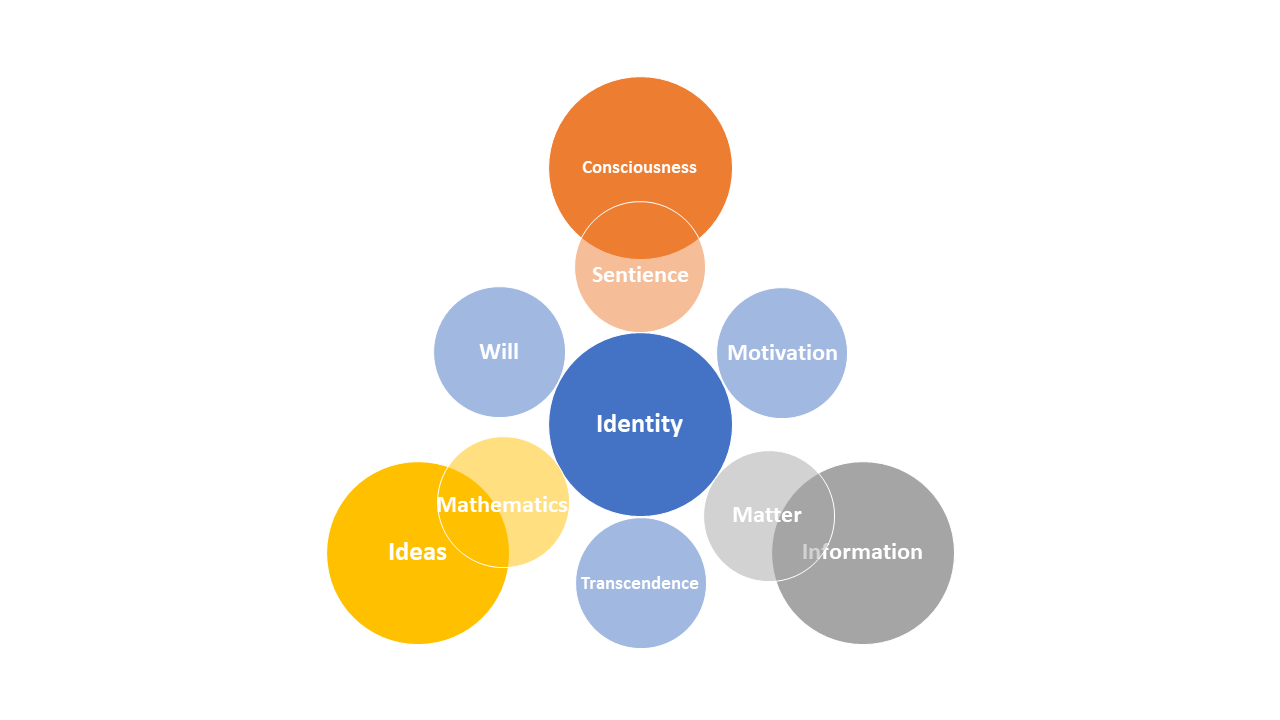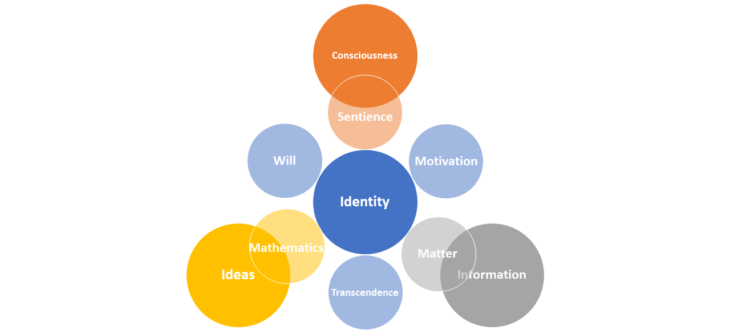What are the different types of elements that make up reality in its most essential aspect?
There are very different answers to that question. We can interpret reality under many paradigms [1] [2] and the answer we give to that question will be different depending on the paradigm we use.
What if we wanted to take into account all possible paradigms of interpretation of reality?
If we want to develop a sentience simulation project [3], that admits as many hypotheses and theories about sentience as possible, we will find that obviously in such an environment it will not be enough to represent the sentience alone, but surely we will have to include other types of substances that may be related to it. To give a very simple example, if we consider that sentience is a real thing that emerges from a wet biological animal material brain, and we want to represent a living frog that feels in our system, the simulation environment must support the representation, in one way or another, of at least two types of objects or concepts: material objects (such as the frog’s brain or whole body and the physical environment where it lives) and sentient objects (such as the frog’s experiences).
Because of this, when simulating sentience, elements that are not purely sentience should generally also be simulated; and if we want to have an environment that admits all possible hypotheses and theories about sentience, then to be very sure of leaving nothing out, it would be very interesting to be able to include as types of simulation objects all kinds of possible components of reality according to all kinds of paradigms, theories and beliefs.
Then, how many different types of elements must be able to exist in that simulation environment?
This is the question that this text intends to answer.
I consider that there are at least four possible types of constituent elements of reality. Obviously, depending on our favorite theory, some may not exist or several of them may be the same.
- Information, being a particular case the Matter
- Ideas, being a particular case the Mathematics
- Consciousness, being a particular case the Sentience
- Identity
- Others such as Will and Motivation, and a very particular one that is Transcendence

Next I will describe the different types of objects proposed.
The world of ideas (yellow), the material world (gray) and the world of experiences (orange)
Yellow balloons reflect the platonic worlds, of perfect ideas, like mathematical ideas. Gray balloons refer to materialism, matter can be considered simply as information. In orange we have the subjective, conscious states including the senses, and in particular the sentience [4] or ability to experience situations that are subjectively not indifferent and therefore are valued positively (such as pleasure and enjoyment) or negatively (such as pain and the suffering).
Identity (dark blue)
When we are aware we are aware of something, right? If that “something” of which we are aware is our own capacity for self-knowledge [5], the information (true or not) that we have about ourselves participates in the construction of the idea (true or not) that we have about ourselves, giving attributes to our identity, separate from everything else (whether or not there is such a thing).
Will (light blue)
We can experience something we might call: the ability to make decisions, will, free will or freedom. This can be understood as simply doing what we are programmed to do, in the same way that an algorithm makes decisions according to its programming, or relate it more to the idea of desire (interpreting “will” rather as “desire” or “motivation”), which in its basic form cannot be otherwise than wishing for positive states (which is why they are positive, because they are desirable, and are desirable because they are positive) and wishing to avoid negative states. In more complex ways [6], for example, small negative states can be accepted to achieve large positive states; as well as to avoid large negative states. The will can also be interpreted as a decision-making that does not depend on material components (information) —external— but of another type —internal—, strongly linked to the idea of identity which in this case can be equated with spirituality (which includes personality and subjectivity). I insist: I include the will in this text not because I think it exists, but because it is a necessary element to represent some metaphysical hypotheses about reality in a computer simulation. In doing so, or in trying to do so, we may discover that the will does not exist because it is meaningless, that is, it is ill-defined. This will prompt us to discard or redefine it.
Motivation (light blue)
We can experience the motivation to act or to stop doing it (on the material world) in a certain way, to think or to stop doing it in a certain way (thoughts could be ideas), just as we have intrinsic motivation (by definition) to experience positive states but no negatives (sentience).
What would be the difference between Willpower and Motivation in a simulation? The Will would be the ability to make decisions, which may or may not exist, be greater or lesser. In its binary nature I call it “Will”, and in its gradual nature I call it “Motivation”. How can the Willpower be gradual? We are used to understanding that the rules (or neurons, or any basic processing units) are either triggered or they don’t. But we could consider will as the gradual ability to trigger rules, which could be general (for example, rules are triggered if conditions are met, but only 50% of the time) or specific to each rule (some rules are fire more likely than others). The greater the will, the greater the ability to fire rules. This ability would be independent of the surrounding reality. Instead, motivation would be associated with specific states of the material, mathematical or sentience world, such that some situations motivate more than others.
Transcendence (light blue)
I have included in the graph the idea of transcendence. The word transcendence can have multiple meanings and could be considered another type of possible component of reality, but in turn, of “operator” type. As I am going to propose now, transcendence could be considered as a particular case of operations that can be done between the basic elements that constitute reality, transforming one element into another, duplicating it or “changing it”, which in a simulation It would be the same as transforming it into another element.
To clarify this which is surely confusing, let’s think that the basic elements graph is a spatial representation (for example, in the form of a pyramid seen from above). The idea of transcendence could be understood as the existence of movements within this pyramid, more or less complex.
We have said that the idea of transcendence can have multiple meanings. For example, “transcendence” may refer to the subjective identity enduring in the world of ideas in the minds of others or represented in material form; or that the subjective identity reaches a higher state that we could consider “another world”. A generalization of these examples of transcendence, oriented to the realization of these simulations, is to consider transcendence as the ability to transform one type of entity into another, either in “copy and paste” mode, or in “cut and paste” mode. ” Transcending in the form of “dying and going to Valhalla” would be “cutting and pasting” the identity, which passes from a low plane to a higher one. Transcending in the form of a loved one, of being represented in a statue or of appearing in the history books could be represented with similar operations, although more complex, copying attributes of some types of elements to others, for example, taking my ideas, My thoughts, to a material support: a book.
…
Monism, dualism, trialism, quadrialism and beyond
There are several hypotheses about the different number of types of fundamental substances that can exist.
Monistic theories (monism) defend a single type of substance that composes reality (for example, matter —materialism—. Others instead claim that is the spirit or psyche —panpsychism—).
Dualistic theories (dualism) defend two types of substances (for example, body and mind) or two worlds (earth and sky).
Trialist theories (trialism) defend the existence of three types of substances or three types of realities. The graphic presented here resonates with the doctrine of the three worlds of Karl Popper. In it, Popper divides the world into three categories:
- World 1: Physical. The world of objects, not only visible, also things that escape the human eye. It is the world of physical objects.
- World 2: Experience / Feeling. The world of mental processes, conscious or unconscious. It is the place where feelings of pain, pleasure and thought occur. It is the world of subjective experiences.
- World 3: Ideas / Knowledge. It is the world where objective knowledge is found.
In his book “In search of a better world”, in the first of his articles (“Knowledge and configuration of reality”), Popper speaks of three worlds. World 1, the material; world 2, that of experience, and world 3, that of the products of the human mind; and indicates that it seems clear that world 1 is the creator of world 2.
In a way trialism could be considered a level of complexity sufficient to represent all theories, but from other approaches, it may not be enough, and we have to go to a “quadrialism” —or “quatrialism”— (adding identity as a fourth element) and even go further. A complete simulation environment must support monism, dualism, trialism, quadrialism, etc.
…
[2] https://manuherran.com/a-map-of-metaphysical-theories-of-sentience/
[4] https://manuherran.com/how-to-recognize-sentience/
[5] https://manuherran.com/on-theories-of-sentience-a-talk-with-magnus-vinding/
[6] https://manuherran.com/asymmetries-and-compensations-between-pleasure-and-pain/

Thank you